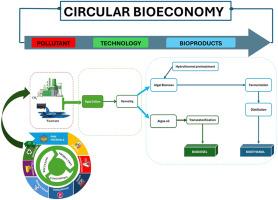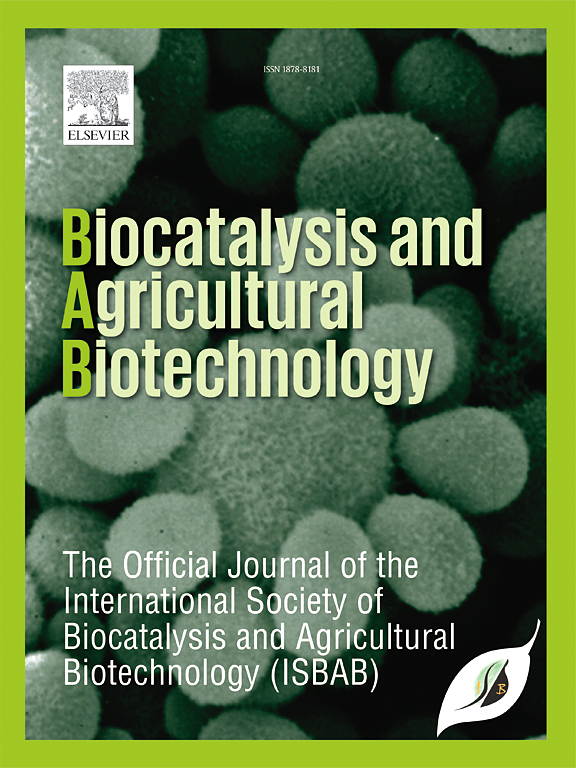利用本地分离的藻类生物质生产和优化生物燃料:循环经济一体化战略
IF 3.8
Q2 BIOTECHNOLOGY & APPLIED MICROBIOLOGY
引用次数: 0
摘要
在本研究中,我们调查了本地分离的藻类菌株作为可持续生物燃料生产替代能源的潜力。本研究的重点是鉴定能够积累富含必需脂肪酸油脂的藻类菌株。研究人员从不同地区收集了藻类样本,并获得了 14 个分离株。在测试的各种预处理方法中,使用硫酸在 95 °C 下进行水热预处理的效果最好,样品 IIB-14 含有超过 2% 的还原糖。然后利用这些糖与 S. cerevisiae 菌株进行发酵,得到的乙醇浓度为 3.52% ± 0.2%。这种综合方法有助于开发低成本、环保的传统能源替代品。虽然藻类生物燃料有望成为化石燃料的替代品,但要在燃料市场上广泛应用,还需要进一步的改进。在这些分离物中,IIB-8 和 IIB-9 的产油量最高,分别为 22.84% 和 24.69%(重量比)。确定了这些菌株最佳生长的特定环境条件,并分析了油的理化参数,包括碘值、粘度、密度、酸值、皂化值、不皂化物质量和过氧化值。通过将油脂酯交换成脂肪酸甲酯(FAMEs),发现其中含有大量脂肪酸,包括 EPA、DHA 和亚油酸。此外,该研究还探讨了藻类生物质生产生物乙醇的潜力,以解决可再生能源供应的可持续性问题。在 95 °C 温度下使用硫酸进行水热预处理,IIB-14 中还原糖的浓度最高(2%)。从海藻生物质中提取的糖用于发酵。发酵过程中使用的酿酒酵母菌株产生的乙醇浓度为 3.52% ± 0.2%。这种综合方法有助于开发低成本、环境友好型的可再生能源替代品。藻类生物燃料可作为化石燃料的实用替代品,但要进入燃料市场并得到广泛应用,还有很长的路要走。本文章由计算机程序翻译,如有差异,请以英文原文为准。

Production and optimization of biofuels from locally isolated algal biomass: Strategies for circular economy integration
In the present study, we investigated the potential of locally isolated algal strains as alternative energy sources for sustainable biofuel production. The focus of this study was to identify algal strains that are capable of accumulating oils rich in essential fatty acids. Algal samples were collected from different areas and 14 isolates were obtained. Among the various pretreatment methods tested, hydrothermal pretreatment using sulfuric acid at 95 °C yielded the best results, with sample IIB-14 containing more than 2% reducing sugars. These sugars were then used for fermentation with the S. cerevisiae strain, resulting in an ethanol concentration of 3.52% ± 0.2%. This holistic approach contributes to the development of low-cost and environmentally friendly alternatives to traditional energy sources. While algal biofuels offer a promising substitute for fossil fuels, further advancements are needed before they can be widely adopted in the fuel market. Among these, isolates IIB-8 and IIB-9 showed the highest oil yields of 22.84% and 24.69% (w/w), respectively. The specific environmental settings for optimal growth of these strains were determined, and the physicochemical parameters of the oils, including iodine value, viscosity, density, acid value, saponification value, unsaponifiable mass, and peroxide value, were analyzed. The transesterification of oils into fatty acid methyl esters (FAMEs) revealed the presence of significant amounts of fatty acids, including EPA, DHA, and linoleic acid. Moreover, the study also explored the potential of algal biomass for bioethanol production, addressing the sustainability concerns of renewable energy supplies. Hydrothermal pretreatment using sulfuric acid at 95 °C yielded the highest concentration of reducing sugars (>2%) in IIB-14. Sugar extracted from algal biomass was used for fermentation. The Saccharomyces cerevisiae strain used for the fermentation process yielded an ethanol concentration of 3.52% ± 0.2%. This holistic approach contributes to the development of low-cost and environment-friendly alternatives to renewable energy sources. Algal biofuels may offer a practical substitute for fossil fuels, but there is still a long way to go before they can enter the fuel market and are widely used.
求助全文
通过发布文献求助,成功后即可免费获取论文全文。
去求助
来源期刊

Biocatalysis and agricultural biotechnology
Agricultural and Biological Sciences-Agronomy and Crop Science
CiteScore
7.70
自引率
2.50%
发文量
308
审稿时长
48 days
期刊介绍:
Biocatalysis and Agricultural Biotechnology is the official journal of the International Society of Biocatalysis and Agricultural Biotechnology (ISBAB). The journal publishes high quality articles especially in the science and technology of biocatalysis, bioprocesses, agricultural biotechnology, biomedical biotechnology, and, if appropriate, from other related areas of biotechnology. The journal will publish peer-reviewed basic and applied research papers, authoritative reviews, and feature articles. The scope of the journal encompasses the research, industrial, and commercial aspects of biotechnology, including the areas of: biocatalysis; bioprocesses; food and agriculture; genetic engineering; molecular biology; healthcare and pharmaceuticals; biofuels; genomics; nanotechnology; environment and biodiversity; and bioremediation.
 求助内容:
求助内容: 应助结果提醒方式:
应助结果提醒方式:


